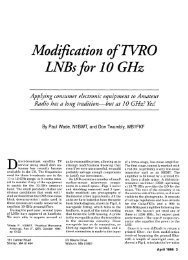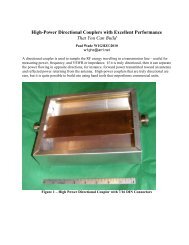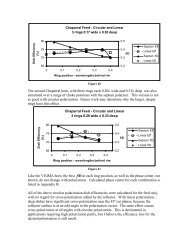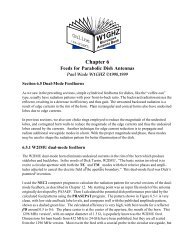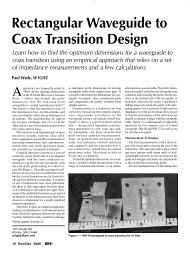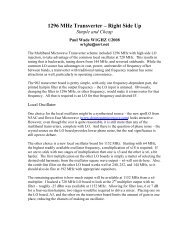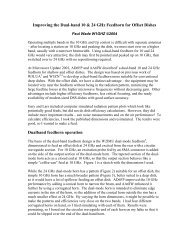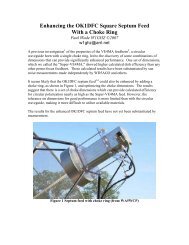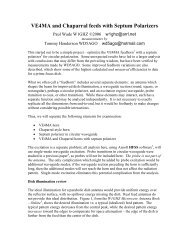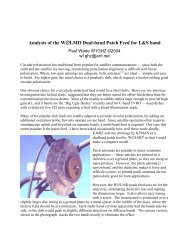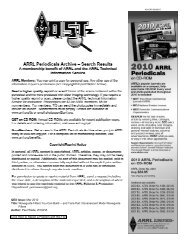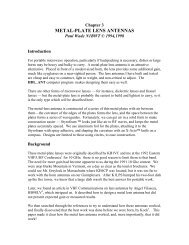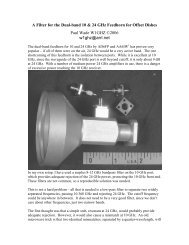Multiband Microwave Transverters for the Rover - W1GHZ
Multiband Microwave Transverters for the Rover - W1GHZ
Multiband Microwave Transverters for the Rover - W1GHZ
- No tags were found...
You also want an ePaper? Increase the reach of your titles
YUMPU automatically turns print PDFs into web optimized ePapers that Google loves.
A single mixer, <strong>the</strong> ADE-18W, is used <strong>for</strong> both transmit and receive. The IF port isbrought out to a connecter, to provide 144 MHz output on receive and input on transmit.The transmit IF level should be no more than 0 dBm at 144 MHz.The output of <strong>the</strong> mixer goes to <strong>the</strong> third pipe-cap filter to remove <strong>the</strong> image and any LOleakage, <strong>the</strong>n to a resistive splitter to separate transmit and receive. My first prototypeused three probes in <strong>the</strong> pipe-cap <strong>for</strong> separate transmit and receive, a trick that K2CBAused in his Easyverter 7 . It worked, but getting <strong>the</strong> probes matched proved to be touchy,and <strong>the</strong> loss was no better than <strong>the</strong> resistive splitter. Two extra resistors are easier thansomething requiring adjustment.The transmit path has an ERA-2 amplifier, A2, <strong>the</strong> fourth pipe-cap filter, and an ERA-5power amplifier, A3. The receiver uses a low-noise GaAs MMIC, <strong>the</strong> MGA-86576, atA1 to overcome <strong>the</strong> loss of <strong>the</strong> mixer and filter. Noise figure should be more thanadequate <strong>for</strong> a low power station. The front-end is wide open, so a real filter is suggested<strong>for</strong> operation on mountaintops or near cell towers.Assembly and TuneupThe first step in assembly is to solder <strong>the</strong> pipe caps to <strong>the</strong> board, after drilling and tapping<strong>the</strong> 10-32 screw holes in <strong>the</strong> top of <strong>the</strong> caps. Each pipe-cap location has a hole at <strong>the</strong>center, halfway between <strong>the</strong> probe locations. I scribe lines on <strong>the</strong> bare board 5/8” awayfrom <strong>the</strong> center hole, making a square to line up each pipe cap. Then I put a bit of pasteflux on <strong>the</strong> rim of each cap, place <strong>the</strong> caps in position, and put a ring of wire solderaround <strong>the</strong> base of each cap. I solder <strong>the</strong> caps one at a time, holding <strong>the</strong> one beingsoldered in position with a screwdriver while heating <strong>the</strong> top of <strong>the</strong> cap with a hot air gun.The copper conducts <strong>the</strong> heat down to <strong>the</strong> board; when <strong>the</strong> joint reaches temperature, <strong>the</strong>ring of solder melts and flows around <strong>the</strong> base of <strong>the</strong> cap, without overheating <strong>the</strong> board.As soon as <strong>the</strong> solder flows, remove <strong>the</strong> heat, let it cool until <strong>the</strong> solder solidifies, <strong>the</strong>nmove on to <strong>the</strong> next cap. A torch could also be used, but tends to oxidize <strong>the</strong> copper.All o<strong>the</strong>r components are surface-mount, on <strong>the</strong> side of <strong>the</strong> board opposite <strong>the</strong> pipe caps,shown in Figure 12. I recommend “No-clean” solder like Kester 245, preferable 0.020”in diameter or smaller – <strong>the</strong>n we don’t have to worry about cleaning liquids getting into<strong>the</strong> pipe caps and o<strong>the</strong>r unwanted places. Tin-lead solder works fine, and <strong>the</strong>re is noreason <strong>for</strong> hams to worry about lead-free solders.



